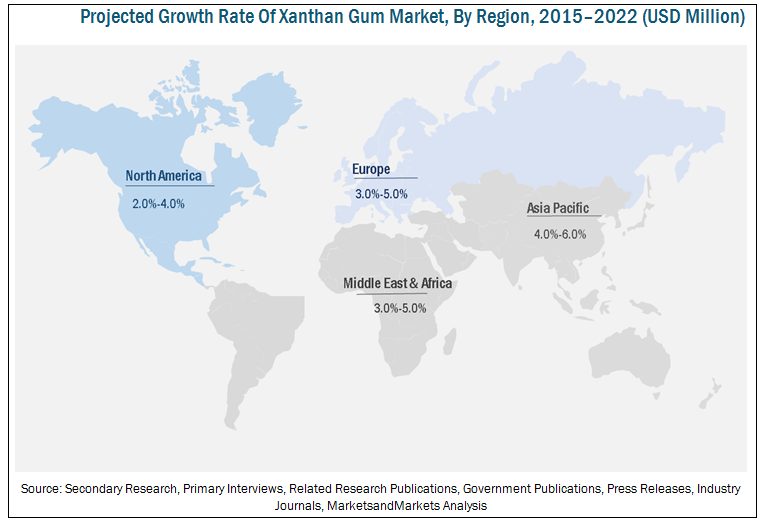Xanthan gum is a natural polysaccharide and is used in various industries such as food & beverage, oil & gas, personal care, pharmaceutical, textile, and pet food. The increase in demand for various processed food & beverage products, gluten-free products, and rise in oil & gas extraction activities are some of the main factors that are driving the market for xanthan gum.Moreover, the upcoming opportunities in the oil & gas industry in the emerging markets for developing countries such as Brazil and Argentina are expected to drive the market for xanthan gum. Furthermore, the increase in the use of personal care products with natural ingredients in countries such as China, Japan, and India are creating considerable opportunities for the xanthan gum market. However, the use of guar gum as a substitute for xanthan gum is restricting its market growth.
Request for Sample Report Pages: https://www.marketsandmarkets.com/requestsampleNew.asp?id=171291392
The global market for xanthan gumis projected to reach USD 452.8million by 2022, at a CAGR of 3.25%.
The xanthan gum market has witnessed dynamic growth trends in the last five years. Globally, the multifunctionality of xanthan gum has prompted its huge scope appropriation in various applications. Changes in consumer lifestyles, rise in consumption of processed food, and growth in the number of oil and gas companiesare some of the components that are driving the market for xanthan gum. The primary purpose behind the utilization of xanthan gum in processed foods is to change the thickness of the substances used, relying on the amount used. Food products such as ketchup are among those processed with xanthan gum added to optimize its thickness, thus driving its market growth.
The multifunctional nature of xanthan gum aids its adoption across other application areas
The xanthan gummarketposes considerable growth opportunities as its current consumption continues to grow in tandem with the consumption of convenience food products. It is also used in non-food applications such as oil & gas drilling, fracturing, pipeline cleaning, and completion. Due to its stability with salt and resistance to thermal degradation, it is used as an additive in drilling fluids. It is one of the key ingredients in the hydraulic fluid used in the hydraulic fracking process. Hence, the multi-functionality of xanthan gum, coupled with the growing demand in the convenience food & beverage products and from the oil & gas industry, drives its market growth. However, the strict anti-dumping policiesagainst xanthan gum areamong the major challenges for this market.
The food & beverages segment to dominate the application segment of the xanthan gum market
The application segment of the xanthan gum market was dominated by food & beverages. Xanthan gum is used in bakery, sauces& dressings, dairy, meat & poultry, beverages, and various other applications. The Xanthomonas campestris strain that is used to yield xanthan gum is non-pathogenic and non-toxic to animals and humans. Hence, it has become the preferred ingredient than other substitutes.Xanthan gum aids to enhance the texture, stability, extending shelf life, and water retention of various confectionery food products such as ice creams and fruit cakes. Moreover, the major factors responsible for the demand for xanthan gum in confectionery applications are the benefits it offers such as better flavor release, reduced hot viscosity, and good gel clarity.
Make an Inquiry: https://www.marketsandmarkets.com/Enquiry_Before_BuyingNew.asp?id=171291392
Geographical Prominence
The North American regionaccounted for the largest share in the global market in 2015, followed by Europe. The thickening and stabilizing properties of xanthan gum aids to enhance the texture of the food products. These unique properties of xanthan gum have led to the increase in its use in confectionery products such as toppings and other bakery products in countries such as the US, Canada, and Mexico, where the processed food industry is growing significantly. The key market players in the North American xanthan gum market include Cargill (US), Archer Daniels Midland Company (ADM) (US), and DuPont (US). They offer high-quality xanthan gum for a wide array of applications, such as hair care, skincare, bakery, and oilfield applications.
The Asia Pacific region is the fastest-growing market in the global xanthan gum market. Industry participants in the region are instrumental in fueling the xanthan gum market growth. Expansion and investment activities are undertaken by these companies in the Asia Pacific region are projected to drive the Asian xanthan gum market. The region is witnessing a growing trend in the use of xanthan gum due to its thickening properties.Consumers in emerging countries such as India, China, and Japan prefer personal care products withgood-quality and natural ingredients. Moreover, it has been found that consumer expenditure in the AsiaPacific region showcases a strong demand for natural personal care products, which in turn has led to the increase in demand for xanthan gum by the personal care industry in this region.
Conclusion
The global market for xanthan gum witnessed strong growth prospects in 2015. North America dominated the market for xanthan gum, followed by Europe and Asia Pacific. The market was primarily driven by the growing consumption of processed food & beverage products. The Asia Pacific region is projected to be the fastest-growing market for xanthan gum. In developed countries, the largest consumers of xanthan gum are the confectionery, baking, dairy, and prepared food industries, which, on average, account for half of the consumption.




